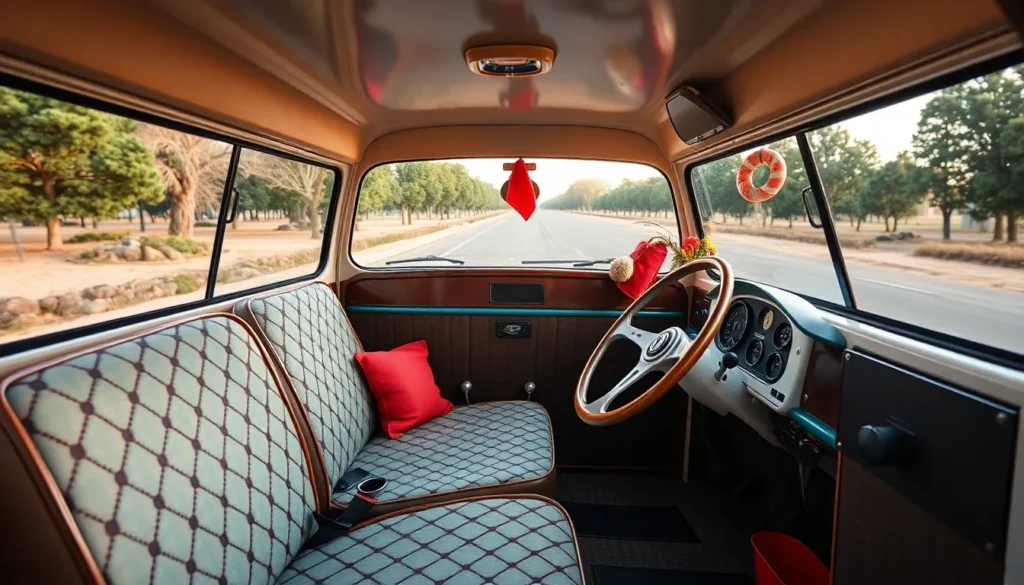The Volkswagen Bus interior represents more than just a vehicle’s cabin – it’s a canvas for adventure and self-expression. Whether you’re restoring a classic 1960s microbus or customizing a modern iteration we’ve seen countless enthusiasts transform these iconic spaces into personalized havens that reflect their unique lifestyle and travel dreams.
From the original split-window models to the latest California editions Volkswagen Bus interiors offer incredible versatility and charm. We’ll explore everything from authentic restoration techniques to modern upgrades that enhance comfort without sacrificing that timeless VW aesthetic. The magic lies in balancing functionality with the nostalgic appeal that makes these vehicles so beloved.
Understanding your interior options is crucial whether you’re planning weekend camping trips or cross-country adventures. We’ve gathered insights from restoration experts builders and long-time VW enthusiasts to help you make informed decisions about your bus interior project.
Classic Volkswagen Bus Interior Design Elements That Define the Iconic Look
The timeless appeal of Volkswagen Bus interiors stems from distinct design elements that have remained consistent across decades. These signature features create the unmistakable aesthetic that enthusiasts and designers continue to celebrate today.
Original Factory Seating Configurations
Factory bench seats dominated the original VW Bus interior layout with their simple yet functional design. We see these wide vinyl benches spanning the full width of the cabin in early models, providing seating for multiple passengers while maximizing space efficiency. The front seats featured a distinctive split design that could fold forward for easier access to the rear compartment.
Removable rear seating became a standout feature that set the VW Bus apart from traditional vehicles. These modular bench seats could be completely removed or repositioned to create cargo space or sleeping areas. The attachment system used simple brackets and wing nuts, allowing owners to reconfigure their interior layout within minutes.
Walk through access between front and rear seats eliminated the traditional barrier found in most vehicles. This open floor plan created a unique social space where passengers could move freely throughout the cabin during stops. The absence of a center console or floor mounted transmission tunnel made this seamless flow possible.
Distinctive Dashboard and Steering Wheel Features
Minimalist dashboard design characterized the VW Bus interior with its clean horizontal lines and functional approach. We find the original dash featured a simple rectangular speedometer positioned directly in front of the driver, often accompanied by basic warning lights for oil pressure and generator function. The glove compartment integrated seamlessly into the passenger side with a distinctive curved handle.
Two spoke steering wheel became an instantly recognizable element with its thin chrome or painted metal construction. The horn button featured the classic VW logo and sat prominently in the center of the wheel. This steering wheel design remained largely unchanged throughout the classic Bus production years.
Exposed metal surfaces throughout the dashboard area reflected the utilitarian philosophy of the original design. Chrome accents appeared on the window cranks, door handles, and dashboard trim pieces. The heating controls consisted of simple lever operated vents positioned low on the dashboard sides.
Iconic Interior Color Schemes and Patterns
Two tone color combinations defined the classic VW Bus interior aesthetic with contrasting vinyl applications. We commonly see combinations like red and white, blue and white, or green and white that matched the exterior paint schemes. These color pairings appeared on seat covers, door panels, and dashboard surfaces.
Diamond pattern vinyl upholstery became synonymous with VW Bus interiors, particularly in later model years. This quilted texture provided both visual interest and practical durability for the active lifestyle these vehicles supported. The pattern appeared most prominently on seat faces while smoother vinyl covered the seat backs and sides.
Natural color palettes dominated early Bus interiors with earth tones like tan, brown, and cream creating a warm atmosphere. These neutral colors complemented the outdoor adventure theme and helped hide wear from sandy feet and camping gear. Safari Beige and Lotus White emerged as particularly popular interior color options that paired well with multiple exterior colors.
Essential Interior Components for Volkswagen Bus Restoration Projects

Restoring a Volkswagen Bus interior requires careful attention to exact components that define the classic aesthetic while ensuring modern durability. We’ll explore the critical elements that transform worn interiors into authentic showcase pieces.
Seat Upholstery and Foam Replacement Options
Original diamond pattern vinyl remains the most sought-after upholstery choice for authentic VW Bus restorations. Marine-grade vinyl offers superior durability against moisture and UV damage compared to standard automotive materials. Classic color combinations include white with red piping, blue with white trim, and all-black configurations that match period-correct specifications.
High-density foam replacement ensures comfortable seating that maintains proper support over decades of use. We recommend 4-inch thick medium-firm foam for bench seats and 2-inch backing foam for optimal comfort. Original seat frames typically require welding repairs before upholstery installation due to rust damage around mounting points.
Custom upholstery shops specializing in vintage vehicles can recreate factory-correct pleating patterns and piping details. Authentic reproductions feature the distinctive diamond quilting with contrasting piping that defines the classic VW Bus interior aesthetic. Modern alternatives include breathable synthetic materials that resist fading while maintaining the original appearance.
Dashboard Restoration and Gauge Upgrades
Dashboard cracks represent the most common restoration challenge due to age and sun exposure in vintage VW Bus interiors. Professional repair involves cleaning existing cracks, applying specialized adhesives, and refinishing with period-correct paint colors. Replacement dashboards cost between $300-800 depending on condition and year compatibility.
Gauge restoration requires careful attention to maintaining original speedometer calibration and appearance. We often find that original VDO gauges need internal cleaning and recalibration to ensure accurate readings. Reproduction gauge faces maintain the classic white-on-black design while incorporating modern reliability improvements.
Modern gauge upgrades include LED backlighting conversions that improve nighttime visibility without altering external appearance. Electronic fuel gauge conversions eliminate the unreliable mechanical sending units that frequently fail in vintage buses. Temperature and oil pressure gauges benefit from modern sensors that provide more accurate readings than original equipment.
Interior Trim and Accent Piece Replacements
Window trim pieces frequently crack or fade, requiring replacement to achieve a complete restoration. Original aluminum trim maintains authentic appearance but reproduction plastic alternatives offer better durability and lower costs. Door handles, window cranks, and interior latches should match throughout the cabin for consistent aesthetics.
Headliner replacement involves specialized techniques to achieve the smooth, wrinkle-free appearance that defines quality restorations. We use marine-grade vinyl headliner material that resists sagging and moisture damage common in vintage buses. Proper installation requires removing all interior trim pieces and carefully stretching material around roof curves.
Floor covering options range from original rubber mats to modern vinyl planking that maintains period-appropriate appearance. Reproduction diamond-plate rubber mats provide authentic texture and easy cleaning capabilities. Sound deadening materials installed beneath floor coverings significantly reduce road noise and improve the overall driving experience in restored VW Bus interiors.
Modern Volkswagen Bus Interior Conversion Ideas for Today’s Adventurers
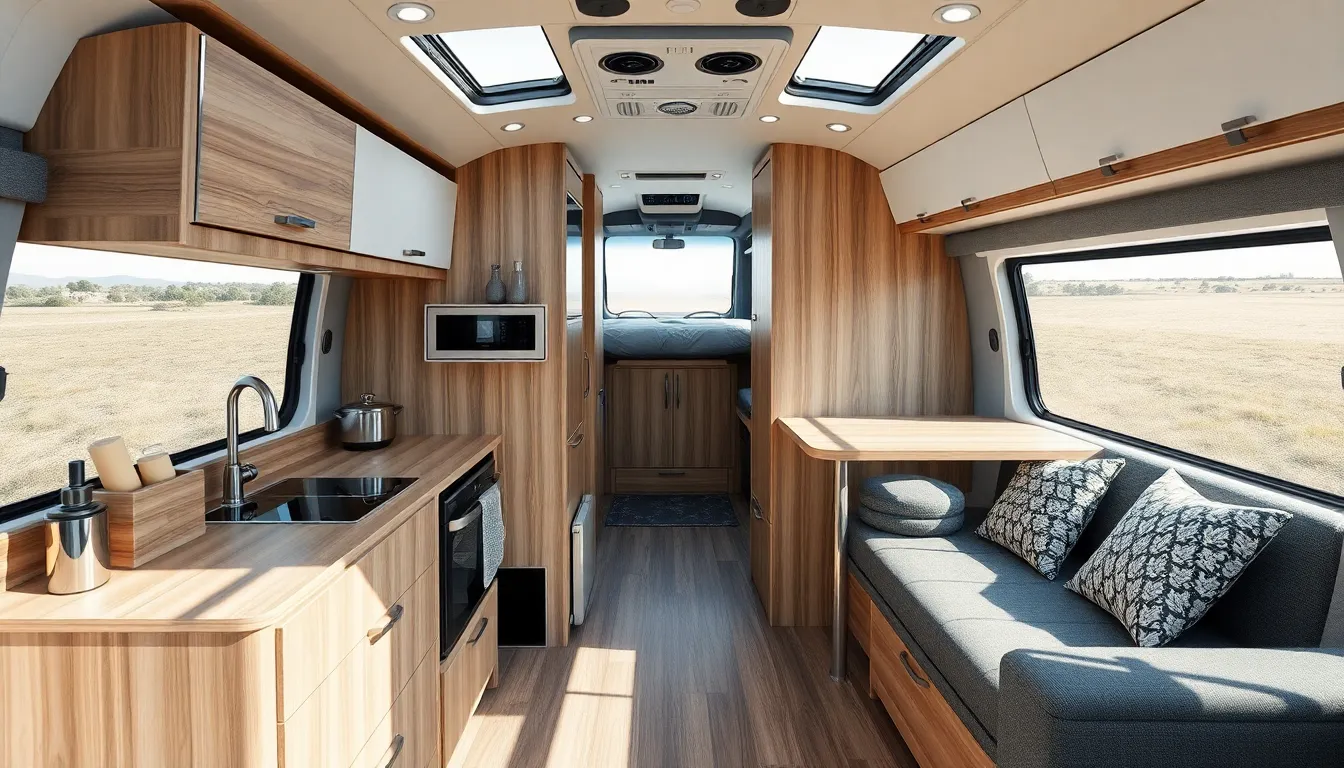
Today’s Volkswagen bus conversions blend classic aesthetics with contemporary functionality. Modern adventurers transform these iconic vehicles into fully equipped mobile homes that serve multiple purposes.
Camper Van Conversion Layouts
Galley-style layouts maximize space efficiency in narrow bus interiors by placing amenities along one side. This configuration creates a clear walkway from front to rear while positioning the kitchen counter, storage cabinets, and seating areas in a linear arrangement. Most conversion specialists recommend this layout for buses under 21 feet because it optimizes the limited width available.
L-shaped configurations use corner spaces effectively by wrapping the kitchen and dining areas around the rear corner of the bus. We’ve seen this design work particularly well in T6 California models where the pop-top provides additional headroom. The L-shape creates distinct zones for cooking, eating, and relaxing without sacrificing valuable floor space.
Open floor plan conversions eliminate fixed furniture barriers to create multipurpose living areas. These layouts feature removable or convertible furniture pieces that transform the space from a dining room to a bedroom to a cargo area. Many modern adventurers prefer this flexibility because it accommodates various trip types and group sizes.
Split-level designs take advantage of the bus’s natural height variations by creating raised sleeping platforms over storage areas. This approach doubles the usable space by positioning beds above gear storage, water tanks, or electrical systems. Professional conversion companies often incorporate this layout in extended wheelbase models.
Kitchen and Dining Area Integration
Compact galley kitchens feature everything needed for meal preparation in a 4-foot section along the bus wall. These setups typically include a two-burner cooktop, small refrigerator, sink with foot pump, and overhead storage for dishes and cookware. We recommend marine-grade appliances because they handle the constant movement and vibration better than residential units.
Modular kitchen systems allow adventurers to customize their cooking setup based on trip requirements. These units slide in and out of designated spaces, making it possible to remove the entire kitchen for cargo hauling or deep cleaning. Companies like VanEssa and Ququq have developed popular modular systems specifically for Volkswagen buses.
Dinette conversions transform the traditional rear bench seating into a proper dining table that seats four adults comfortably. The table typically mounts between two bench seats and adjusts to various heights for dining or workspace needs. Many conversions incorporate storage drawers under the bench cushions for dishes, linens, and food supplies.
Indoor-outdoor kitchen extensions blur the line between interior and exterior cooking spaces through rear hatch designs. These conversions position the cooktop and prep area near the back doors, allowing chefs to cook inside while maintaining connection with outdoor dining areas. This setup works exceptionally well for tailgating and extended camping stays.
Sleeping Quarter Configurations
Rock and roll beds provide the most versatile sleeping solution by converting from rear seating to a full-width bed in seconds. These mechanisms fold the seat back down to create a sleeping surface that typically measures 6 feet by 4 feet. We’ve found that quality rock and roll beds from companies like Rusty Lee maintain their adjustment mechanisms for decades with minimal maintenance.
Pop-top sleeping arrangements double the bus’s sleeping capacity by adding a canvas tent roof that provides standing headroom and upper bunk space. California editions come with this feature standard, but aftermarket pop-tops can be installed on other models. The upper sleeping area typically accommodates two adults on a custom mattress platform.
Murphy bed installations maximize daytime living space by folding the primary sleeping surface against the wall when not in use. These conversions work best in longer wheelbase models where the folded bed doesn’t interfere with the kitchen or seating areas. Many adventurers appreciate having a dedicated bed that doesn’t require daily setup and breakdown.
Convertible lounge configurations transform the main living area into sleeping quarters through modular cushion systems. These setups use identical cushions for both seating and sleeping, eliminating the need for separate mattresses. The cushions typically measure 6 inches thick and use high-density foam that maintains comfort for both purposes.
Budget-Friendly Volkswagen Bus Interior Upgrades That Make a Big Impact
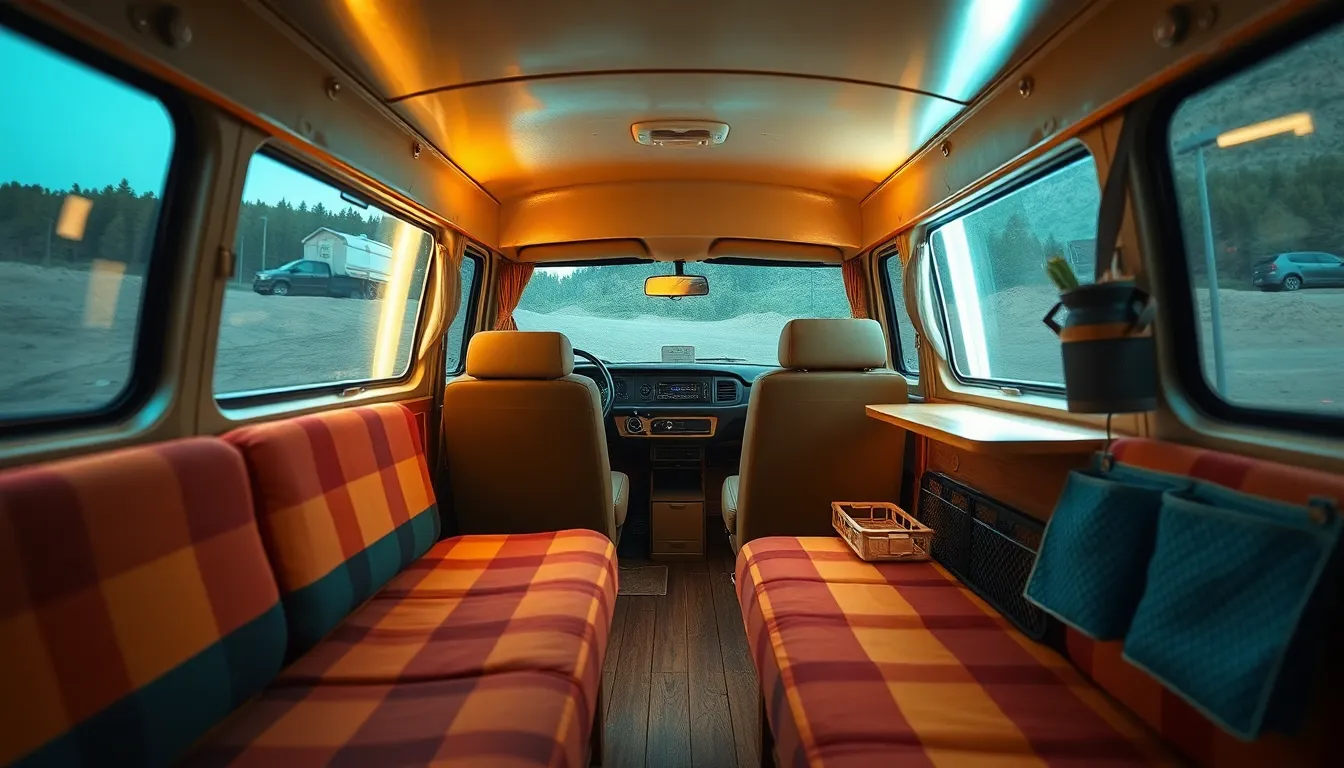
We’ve discovered that transforming your Volkswagen Bus interior doesn’t require a massive budget to achieve stunning results. Smart upgrades can deliver maximum visual and functional impact while preserving your hard-earned cash for future adventures.
DIY Seat Cover and Cushion Projects
DIY seat covers offer the most dramatic visual transformation for the lowest cost in any Volkswagen Bus interior project. We recommend starting with high-quality canvas or marine vinyl fabric that costs between $15-25 per yard and provides excellent durability for daily use. Measuring your existing seats carefully ensures a professional-looking fit that rivals expensive custom upholstery work.
Creating removable covers allows you to wash them easily and change colors seasonally without permanent alterations. We suggest using heavy-duty zippers on the back panels and elastic corners to maintain that snug factory appearance. Adding extra foam padding underneath thin covers instantly improves comfort levels during long road trips.
Pattern making becomes simple when you use your existing seat covers as templates for cutting new fabric pieces. We’ve found that adding contrasting piping around the edges creates that classic VW Bus aesthetic while hiding any imperfect seaming. Simple hand-stitching techniques work perfectly for beginners, though a basic sewing machine speeds up the entire process significantly.
Interior Lighting Improvements
Interior lighting upgrades create an entirely new atmosphere in your Volkswagen Bus for under $100 total investment. We recommend starting with LED strip lights that consume minimal battery power while providing excellent illumination for evening activities. Battery-operated puck lights work perfectly in areas where running electrical wiring seems too complicated or expensive.
Installing rope lights around the ceiling perimeter gives your bus that cozy camping vibe that everyone associates with van life adventures. We suggest choosing warm white LEDs over cool white options because they create a more inviting and comfortable environment for relaxation. Dimmer switches allow you to adjust brightness levels based on different activities throughout the day.
Solar-powered lanterns eliminate the need for complex electrical work while providing portable lighting answers for outdoor use. We’ve discovered that placing battery-operated string lights around windows creates magical ambiance during evening gatherings. Reading lights mounted near seating areas improve functionality without requiring major modifications to your existing electrical system.
Storage Solution Additions
Storage answers maximize your Volkswagen Bus interior space without expensive cabinetry or professional installation services. We recommend starting with over-the-door shoe organizers that create instant storage for small items like toiletries, snacks, and tools. Magnetic strips mounted on metal surfaces hold knives, utensils, and other metal objects securely during travel.
Under-seat storage boxes use wasted space while keeping belongings organized and easily accessible when needed most. We suggest using stackable plastic containers with tight-fitting lids to prevent items from shifting during bumpy rides. Mesh pockets sewn onto existing surfaces create convenient storage for frequently used items like phones, maps, and water bottles.
Ceiling nets stretched between anchor points provide lightweight storage for sleeping bags, pillows, and other bulky items. We’ve found that suction cup hooks work excellently on smooth surfaces and remove easily without leaving permanent damage. Installing simple curtain rods creates hanging storage space for clothing while adding privacy between different areas of your bus interior.
Premium Volkswagen Bus Interior Accessories for the Ultimate Vintage Experience
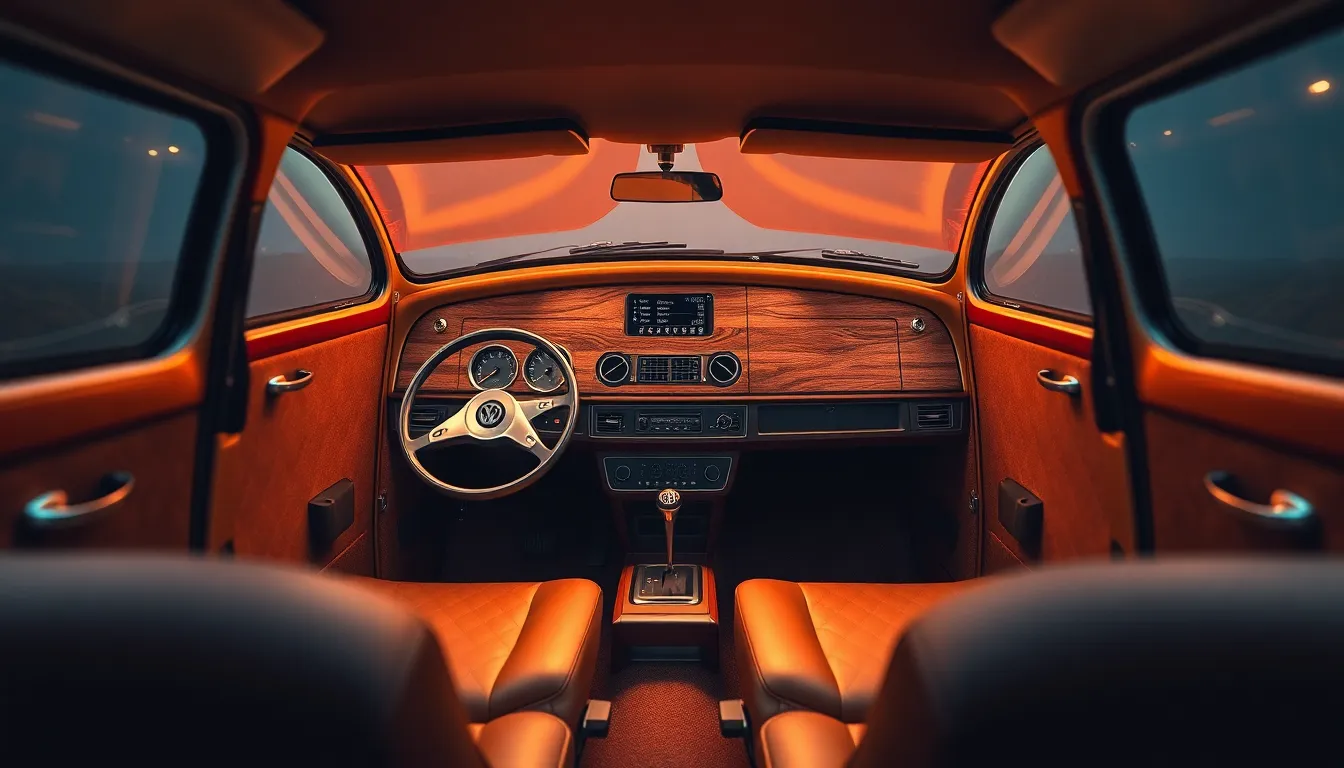
Premium accessories elevate your Volkswagen Bus interior from functional to extraordinary, combining authentic vintage appeal with modern luxury. These carefully selected upgrades preserve the classic character while introducing sophisticated materials and features that enhance both comfort and style.
High-End Upholstery Materials and Finishes
Genuine leather upholstery transforms your VW Bus interior with timeless elegance and superior durability. Full-grain leather seats develop a beautiful patina over time, creating an authentic vintage appearance that synthetic materials can’t replicate. Italian leather specialists like Connolly and Bridge of Weir offer period-correct colors including saddle brown, tobacco, and classic black that complement original paint schemes.
Premium vinyl alternatives provide weather-resistant luxury without compromising the classic aesthetic. Marine-grade vinyl from manufacturers like Spradling and Nassimi delivers exceptional durability against UV rays, moisture, and temperature fluctuations. These materials feature authentic diamond quilting patterns and come in original VW colors like pearl white, sage green, and poppy orange.
Mohair loop carpet represents the ultimate in period-appropriate flooring, offering superior comfort and authentic texture. German manufacturers produce exact reproductions of original VW Bus carpeting using traditional weaving techniques. Custom-fitted carpet sets include precise cutouts for pedals, seat mounts, and interior fixtures, ensuring a factory-perfect appearance.
Headliner materials deserve special attention when pursuing premium quality upgrades. Perforated vinyl headliners provide excellent acoustics while maintaining the classic perforated pattern found in original buses. German suppliers offer reproduction headliners with correct grain patterns and colors, including rare options like bamboo and parchment that were available on exact model years.
Custom Dashboard and Console Modifications
Handcrafted wooden dashboard overlays create striking focal points that honor the natural materials popular in vintage design. Brazilian rosewood, teak, and burled walnut veneers can be professionally fitted over existing dashboards, incorporating modern conveniences like hidden storage compartments and device charging stations. These modifications maintain the minimalist aesthetic while adding sophisticated warmth to the interior space.
Custom gauge clusters blend vintage styling with modern reliability and accuracy. Classic Instruments and VDO offer reproduction gauges that match original specifications while incorporating modern sending units and LED backlighting. Five-gauge clusters can include oil pressure, water temperature, fuel level, voltage, and tachometer readings in authentic VDO or Smiths styling.
Center console additions maximize functionality without disrupting the open floor plan concept. Custom-built consoles incorporate period-appropriate materials like brushed aluminum and leather, housing modern amenities such as cup holders, device storage, and climate controls. These additions can be designed to match seat heights, creating additional seating or armrest functionality.
Switch panels and control interfaces benefit from premium upgrades that maintain vintage authenticity. Aircraft-style toggle switches, vintage radio knobs, and period-correct bezels create cohesive control layouts. Chrome and brushed aluminum finishes complement original trim pieces while providing tactile satisfaction and long-term durability.
Luxury Comfort Features and Amenities
Premium seating systems combine classic styling with modern ergonomics and materials. Custom bucket seats with lumbar support, heating elements, and memory foam padding provide all-day comfort for long adventures. Recaro and Sparco offer vintage-inspired designs that complement VW Bus proportions while delivering contemporary support and safety features.
Ambient lighting systems create sophisticated atmospheres using period-appropriate fixtures and modern LED technology. Brass and chrome light housings can incorporate warm white LEDs, providing gentle illumination for evening relaxation. Reading lights, floor lighting, and cabinet illumination can be controlled through vintage-style switches that maintain the classic aesthetic.
Climate control upgrades ensure year-round comfort without compromising the vintage appearance. Vintage Air systems provide modern air conditioning and heating using components that fit within original spaces. Custom ducting can be routed through existing channels, maintaining clean lines while delivering effective temperature control throughout the interior.
Sound dampening materials dramatically improve ride quality and audio performance. Dynamat and similar products reduce road noise, vibration, and harshness while preserving the lightweight characteristics essential to VW Bus performance. Professional installation ensures complete coverage without adding excessive weight or altering interior dimensions.
Premium floor mats and protective accessories maintain interior condition while adding luxury touches. Custom-fitted German square weave mats, leather floor mats, and coir natural fiber options provide authentic period styling. These accessories protect original surfaces while contributing to the overall premium experience through superior materials and craftsmanship.
Interior Space Optimization Strategies for Volkswagen Bus Owners
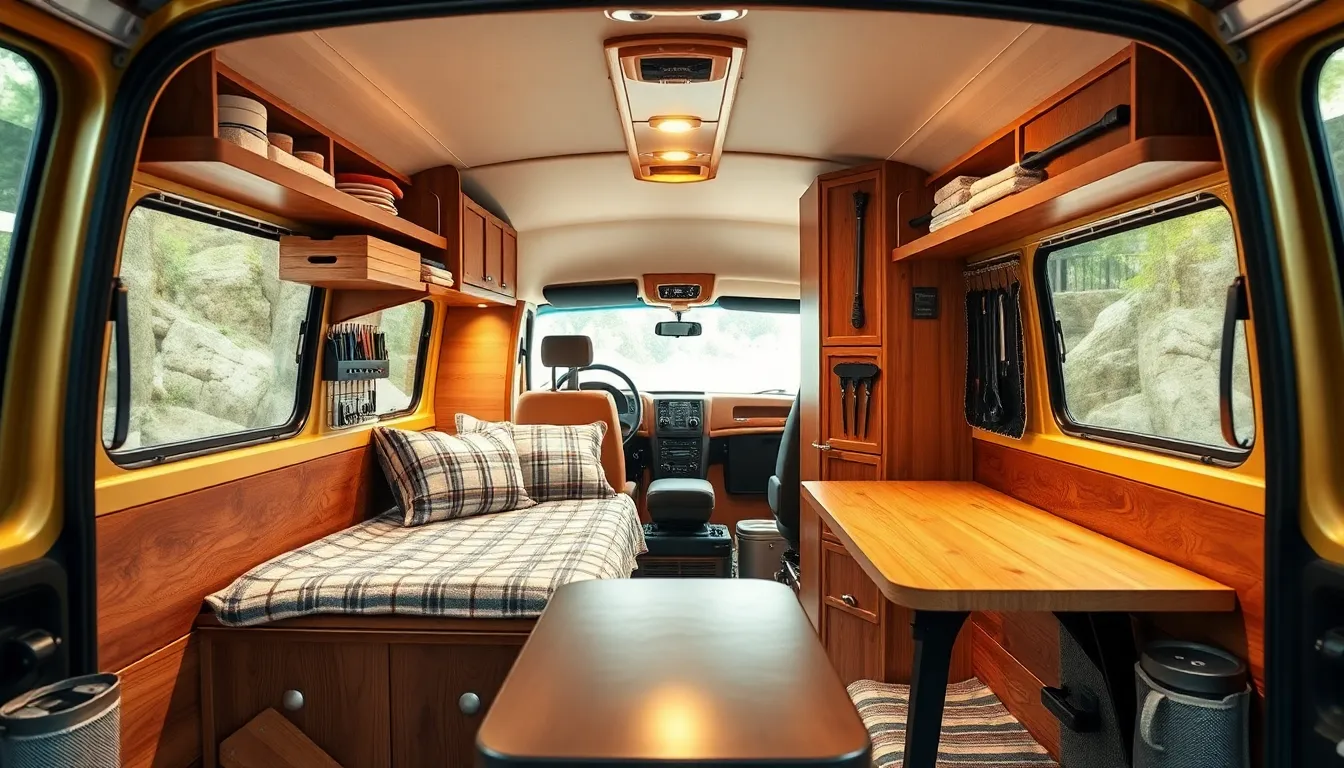
Effective space management transforms your Volkswagen Bus interior from cramped quarters into a comfortable living space. We’ll explore proven techniques that maximize every square inch while maintaining the classic VW aesthetic.
Maximizing Storage in Limited Space
Vertical wall systems create substantial storage capacity without consuming precious floor space. We recommend installing ceiling-mounted nets for lightweight items like clothing and sleeping bags, which can hold up to 15 pounds per square foot. Custom shelving units that follow the Bus’s curved interior walls provide organized storage for kitchen supplies and personal items.
Under-bench storage compartments offer hidden space for larger items like tools and outdoor equipment. Converting the factory wheel wells into pull-out drawers adds approximately 3 cubic feet of accessible storage per side. These modifications work particularly well with marine-grade plywood construction.
Overhead cabin storage utilizes the space between roof ribs for frequently used items. Installing swing-down compartments above the driver and passenger seats creates easy access to maps, electronics, and daily essentials. We’ve seen owners gain an additional 2-3 cubic feet of storage using this approach.
Exterior storage answers extend your capacity beyond the interior walls. Roof racks designed specifically for classic VW Buses can safely carry up to 165 pounds of gear. Rear-mounted cargo carriers and bike racks free up interior space for living essentials.
Multi-Functional Furniture Answers
Rock and roll beds serve as seating during travel and comfortable sleeping quarters at night. These convertible systems typically accommodate two adults and fold completely flat to create a 6-foot by 4-foot sleeping surface. We’ve found that models with integrated storage underneath maximize functionality.
Modular table systems adapt to different activities throughout the day. Removable tabletops can function as cutting boards, laptop desks, or dining surfaces for four people. Many owners create custom brackets that allow tables to mount in multiple locations inside the Bus.
Convertible seating arrangements provide flexible passenger configurations. Swivel captain’s chairs in the front cabin rotate 180 degrees to create a conversation area with rear seating. This setup works exceptionally well for socializing and meal preparation.
Storage ottoman answers combine comfortable seating with hidden compartments. Custom-built ottomans can store up to 2 cubic feet of items while providing additional seating for guests. We recommend using high-density foam tops rated for 300+ pounds.
Clever Organization Systems
Magnetic strips and holders keep metal items secure during travel without permanent installation. Kitchen knives, tools, and spice containers with metal lids stay organized and accessible on vertical surfaces. These systems work particularly well on the interior side panels.
Bungee cord networks create flexible storage for odd-shaped items. Installing anchor points every 12 inches along the interior walls allows you to secure surfboards, fishing rods, and camping chairs safely. This approach prevents items from shifting during transport.
Drawer divider systems maximize the efficiency of existing storage spaces. Custom-cut foam inserts keep fragile items like dishes and electronics organized within pull-out drawers. We suggest using adjustable dividers that accommodate different sized items.
Hanging pocket organizers use door-mounted space for small frequently used items. Over-the-door shoe organizers adapted for VW Bus doors can hold toiletries, snacks, and electronics in individual compartments. These systems add minimal weight while providing substantial organization benefits.
Maintenance Tips for Preserving Your Volkswagen Bus Interior
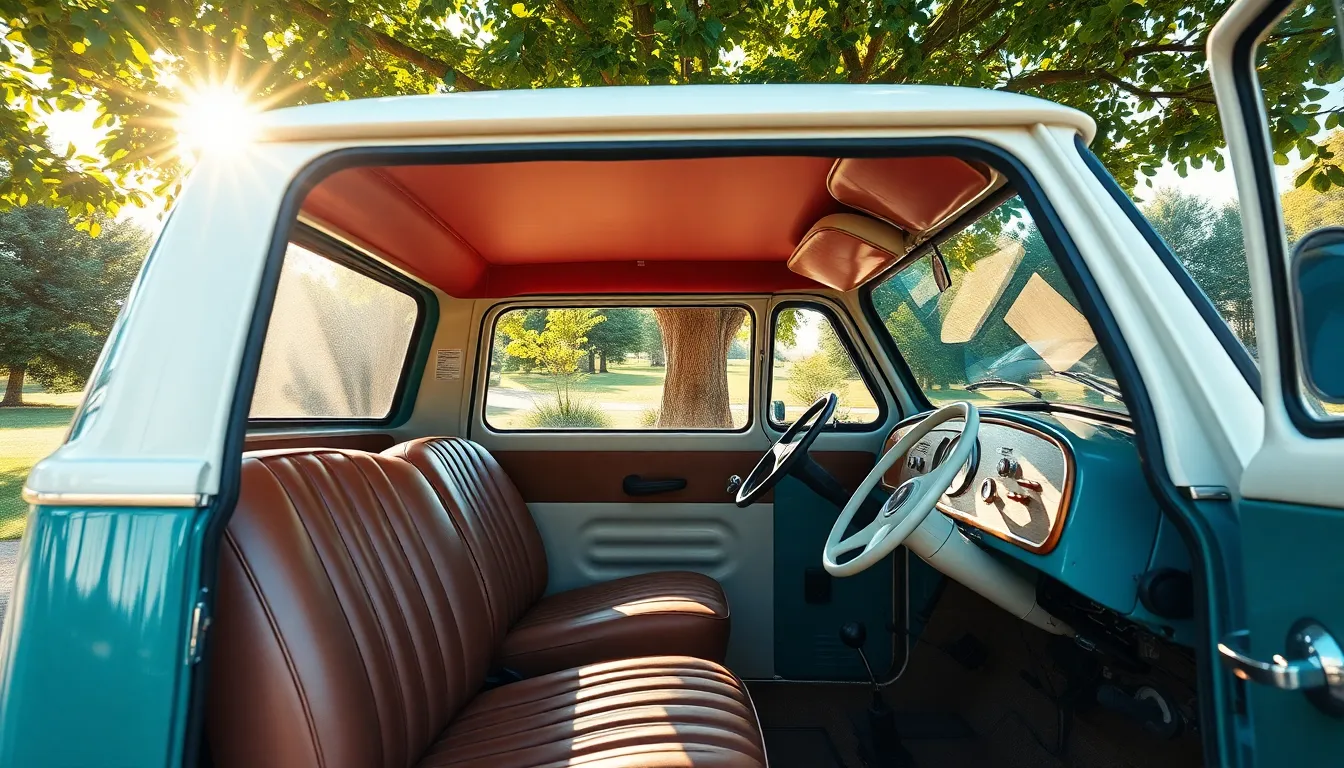
Maintaining your restored or converted Volkswagen Bus interior requires consistent care and attention to detail. We’ll explore proven strategies that keep your interior looking fresh while protecting your investment for years of adventures ahead.
Cleaning and Care for Different Interior Materials
Vinyl upholstery demands gentle cleaning with warm water and mild soap answers. We recommend testing any cleaner on a hidden area first, then applying it with a soft-bristled brush to remove dirt from diamond pattern crevices. Conditioning treatments every three months prevent cracking and fading, especially for original factory materials.
Leather surfaces require specialized care to maintain their premium appearance and feel. Clean leather monthly with pH-neutral cleaners designed specifically for automotive applications, followed by conditioning treatments that restore natural oils. We suggest avoiding harsh chemicals or excessive water that can cause permanent staining or cracking.
Dashboard components need careful attention due to their exposure to UV rays and temperature fluctuations. Dust regularly with microfiber cloths, then apply UV protectant sprays to prevent cracking and fading. Clean gauge faces with barely damp cotton swabs to avoid moisture damage to electrical components.
Carpet and floor coverings benefit from regular vacuuming to remove sand and debris that can cause premature wear. We recommend spot cleaning spills immediately with appropriate cleaners, then allowing complete drying before replacing any removable floor mats. Steam cleaning every six months keeps fibers fresh and removes embedded odors.
Preventing Common Interior Damage Issues
Sun damage poses the greatest threat to Volkswagen Bus interiors, particularly for vehicles with large windows. Install quality window tinting or use reflective windshield covers when parked to reduce UV exposure. We position our buses in shaded areas whenever possible and rotate sun-exposed cushions regularly to ensure even wear patterns.
Moisture control prevents mold, mildew, and rust damage that can destroy interior components. Use moisture absorbing products like DampRid or silica gel packets in closed vehicles, and ensure proper ventilation during storage. We check for water leaks around windows and door seals monthly, addressing any issues immediately.
Wear prevention starts with protective measures for high-use areas like seat edges and door panels. Apply clear protective film to vulnerable surfaces, use seat covers during messy activities, and rotate cushions regularly. We install door edge guards and armrest protectors to minimize damage from daily use.
Pest control keeps unwanted visitors from damaging upholstery and wiring. Store food in sealed containers, vacuum regularly to remove crumbs, and use natural deterrents like peppermint oil around entry points. We inspect for signs of rodent activity monthly and address any issues before they become major problems.
Seasonal Interior Protection Strategies
Winter preparation focuses on moisture control and preventing damage from road salt and snow. Apply fabric protection sprays to upholstery before winter months, use waterproof floor mats, and increase ventilation to prevent condensation buildup. We recommend removing wet items immediately and using portable dehumidifiers during extended storage periods.
Summer protection emphasizes UV damage prevention and temperature management. Install window coverings, use steering wheel and seat covers when parked, and apply protectant to all vinyl and plastic surfaces. We park in covered areas when possible and use reflective dashboard covers to reduce heat buildup.
Spring maintenance involves deep cleaning after winter storage and inspecting for any damage that occurred during cold months. Clean all surfaces thoroughly, check for pest damage, and replace any worn protective accessories. We use this time to condition leather, treat vinyl surfaces, and refresh any fabric protection applications.
Fall preparation includes thorough cleaning before potential storage and protecting against moisture issues. Vacuum completely to remove debris, apply final conditioning treatments, and install moisture barriers if storing the vehicle. We ensure all surfaces are clean and dry before covering or storing our Volkswagen Bus for extended periods.
Conclusion
Your Volkswagen Bus interior represents more than just a vehicle space – it’s a canvas for adventure and self-expression. Whether you’re pursuing an authentic restoration or creating a modern conversion we’ve equipped you with the knowledge to make informed decisions that honor the classic VW spirit.
The journey from planning to completion requires patience and attention to detail but the rewards are immeasurable. Your thoughtfully designed interior will serve as the foundation for countless memories on the road ahead.
Remember that every upgrade maintenance task and design choice contributes to preserving this iconic piece of automotive history. With proper care and creativity your VW Bus interior will continue inspiring adventures for generations to come.
Frequently Asked Questions
What makes the Volkswagen Bus interior so iconic?
The VW Bus interior is renowned for its minimalist dashboard design, distinctive two-spoke steering wheel, classic two-tone color schemes, and diamond pattern vinyl upholstery. The open floor plan promotes social interaction, while removable rear seating allows for versatile cargo or sleeping configurations, embodying the adventurous spirit of these vehicles.
Can I restore my VW Bus interior while maintaining its classic look?
Yes, you can restore your VW Bus interior by using original diamond pattern vinyl, marine-grade materials, and high-density foam for durability and comfort. Focus on dashboard restoration, replacing window trim and door handles, and choosing period-appropriate floor coverings to maintain the authentic aesthetic while improving functionality.
What are the best modern conversion layouts for a VW Bus?
Popular modern VW Bus conversion layouts include galley-style for compact efficiency, L-shaped for maximized counter space, open floor plans for flexibility, and split-level designs for separate living areas. Each layout can be customized with modular kitchen systems and convertible sleeping arrangements to suit different adventure needs.
How can I upgrade my VW Bus interior on a budget?
Budget-friendly upgrades include DIY seat covers using durable fabrics, LED strip lighting for ambiance, and practical storage solutions like over-the-door organizers and under-seat boxes. These improvements significantly enhance both visual appeal and functionality without requiring major investments or professional installation.
What premium accessories are worth investing in for my VW Bus?
Premium upgrades include genuine leather upholstery, custom dashboard overlays with modern gauges, luxury seating systems, and climate control enhancements. Sound dampening materials and protective accessories also elevate comfort while preserving the vintage aesthetic and maintaining the interior’s condition long-term.
How do I maximize storage space in my VW Bus interior?
Maximize storage through vertical wall systems, under-bench compartments, overhead cabin storage, and exterior roof racks. Utilize multi-functional furniture like rock and roll beds and modular tables. Implement organization systems such as magnetic strips, bungee cord networks, and hanging pocket organizers for efficient space management.
What’s the best way to maintain my VW Bus interior?
Regular maintenance involves proper cleaning techniques for vinyl and leather, dashboard care to prevent cracking, and carpet maintenance. Protect against sun damage with UV-resistant treatments, control moisture levels, and implement seasonal protection strategies to prepare for winter storage and summer heat exposure.
Should I choose vinyl or leather for my VW Bus upholstery?
Marine-grade vinyl offers excellent durability and authenticity for classic restorations, while genuine leather provides premium comfort and luxury appeal. Consider your usage patterns, budget, and desired aesthetic. Both materials can maintain the classic VW character when chosen in appropriate colors and patterns.

